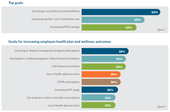
Q&A with Ron Leopold: Investing in benefits communication and top benefits communication goals
Last week we released the results from our Inside Benefits Communication Survey Report. Afterwards we interviewed Ron Leopold and got his feedback on the results. Ron ran the MetLife employee trend study for many years and is one of the most respected names in employee benefits. Our blog posts today and next week will pull out some of the key findings from our survey and dive into Ron’s reactions from our report.
Benz: What findings stood out to you the most in our survey report?
 Ron: Employers are spending a tremendous amount of money per employee on benefits in order to drive employee loyalty and engagement. But sometimes employers shortchange or under-think spending pennies on the dollars to make sure their investment is leveraged. So the small budgets stood out to me the most in your survey report, although the findings aren’t surprising.
Ron: Employers are spending a tremendous amount of money per employee on benefits in order to drive employee loyalty and engagement. But sometimes employers shortchange or under-think spending pennies on the dollars to make sure their investment is leveraged. So the small budgets stood out to me the most in your survey report, although the findings aren’t surprising.
When I talk about benefits communication, I tell people that if they’re offering benefits but not effectively communicating them, they’re missing the point. The money you’re spending on benefits provides value that resonates in the minds and hearts of the men and women who work for you. If a tree falls in the employee benefits forest and you have an associate who doesn’t hear it, it didn’t make a sound.
Benz: How should employers be thinking about that investment in communications?
Ron: This is a new day and age. It’s always been important to communicate the value proposition of benefits. But employees want the benefits they’re getting from their employers more than they did five or ten years ago because the economic circumstance and need is greater. Employees are more eyes and ears than they used to be. And employers can also do a lot more with their benefits communication now. Employers can be more creative and use more channels for getting the message out more elegantly, efficiently and customized to individuals.
People who read the Inside Benefits Communication Survey Report need to take a deep breath, put aside any of their preconceived notions, and recognize that it’s a new world order. Employers should look to making sure that every single man and woman that works for them understands what they’re getting and what it means to them.
Benz: Our survey revealed that employers have a wide breadth of goals when it comes to employee engagement. What advice can you give employers who are trying to tackle many complex behaviors at once?

 Ron: Companies have so many messages and too many things to communicate. It’s a matter of balance. Make the communications as accessible and simple as possible. If your communications are easily digestible and straightforward, your employees will feel comfortable spending time with it.
Ron: Companies have so many messages and too many things to communicate. It’s a matter of balance. Make the communications as accessible and simple as possible. If your communications are easily digestible and straightforward, your employees will feel comfortable spending time with it.
Benz: Employers are saying their biggest challenge is getting employees engaged year round, but few actually communicate year round. Why the disconnect?
Ron: Employers face a bandwidth issue. They can only do so much around enrollment time. Employers need to recognize that some issues around benefits communication are evergreen. Messaging around health and wellness should be year round, especially if employees can enroll in programs during any time of the year. There are many other messages that aren’t anchored to decisions that are made once a year. Be deliberate about communication in February, given enrollment recently closed, but there are still messages that may be relevant. That message may make me act today, or it may go into the memory banks for something I might want to use later on.
Ron Leopold is an independent consultant and a well-recognized industry thought leader focusing on the future of work, health and employee benefits.
Download the full results from our Inside Benefits Communication Survey here.

Jennifer Benz, SVP Communications Leader, has been on the leading edge of employee benefits for more than 20 years and is an influential voice in the employee benefits industry.
